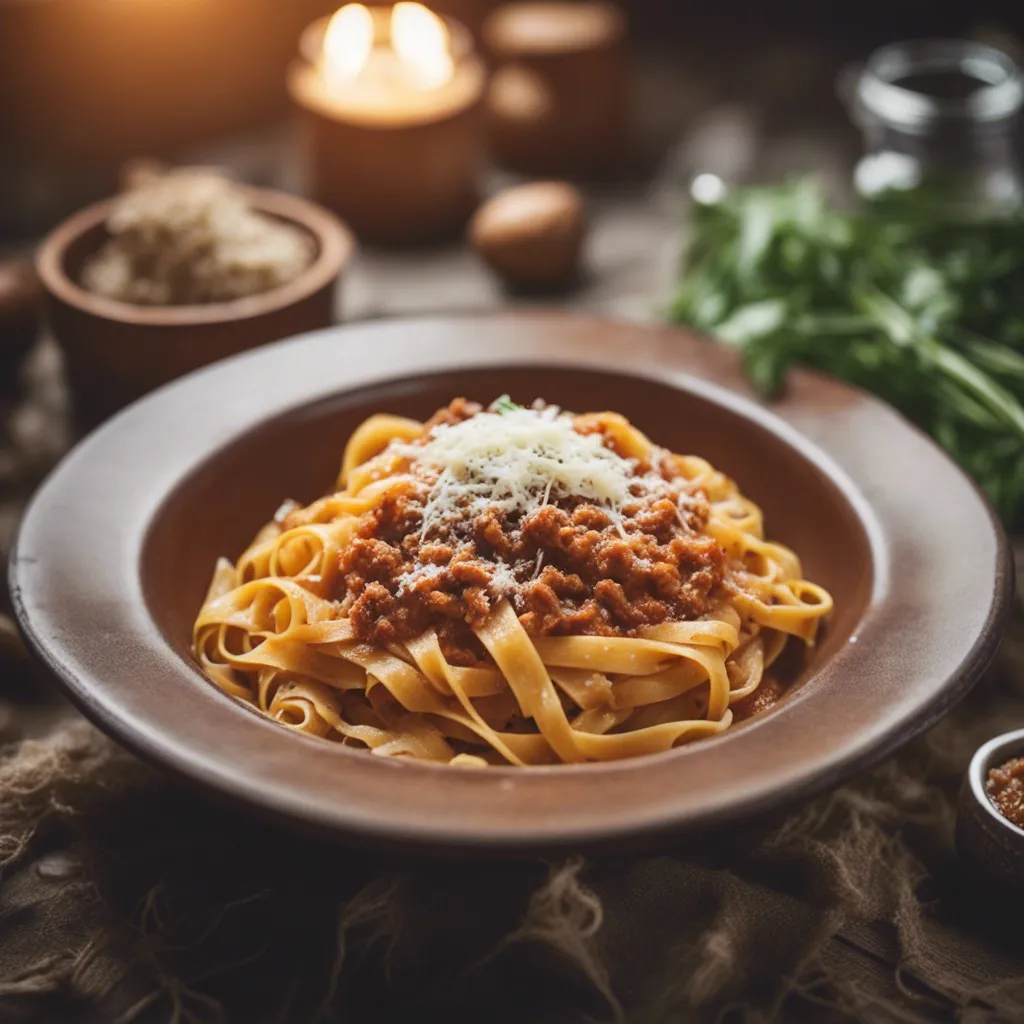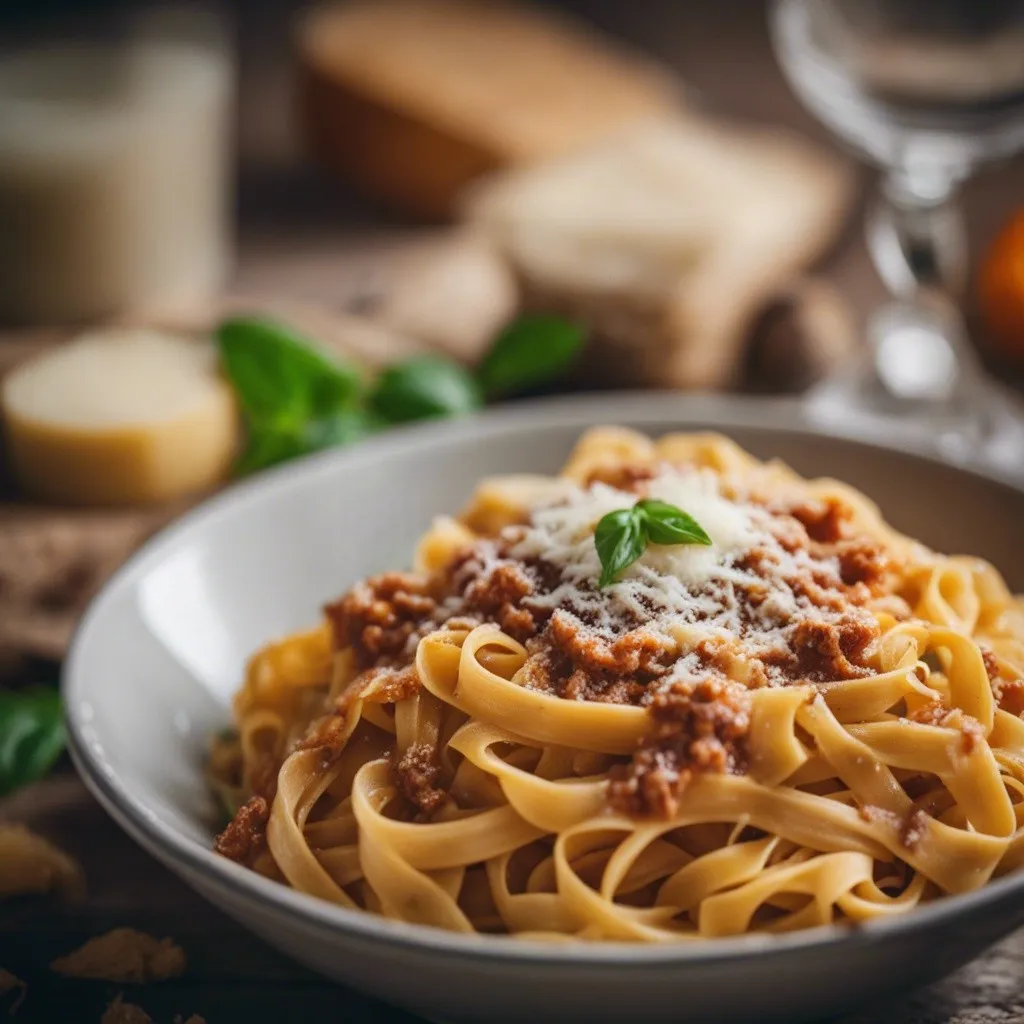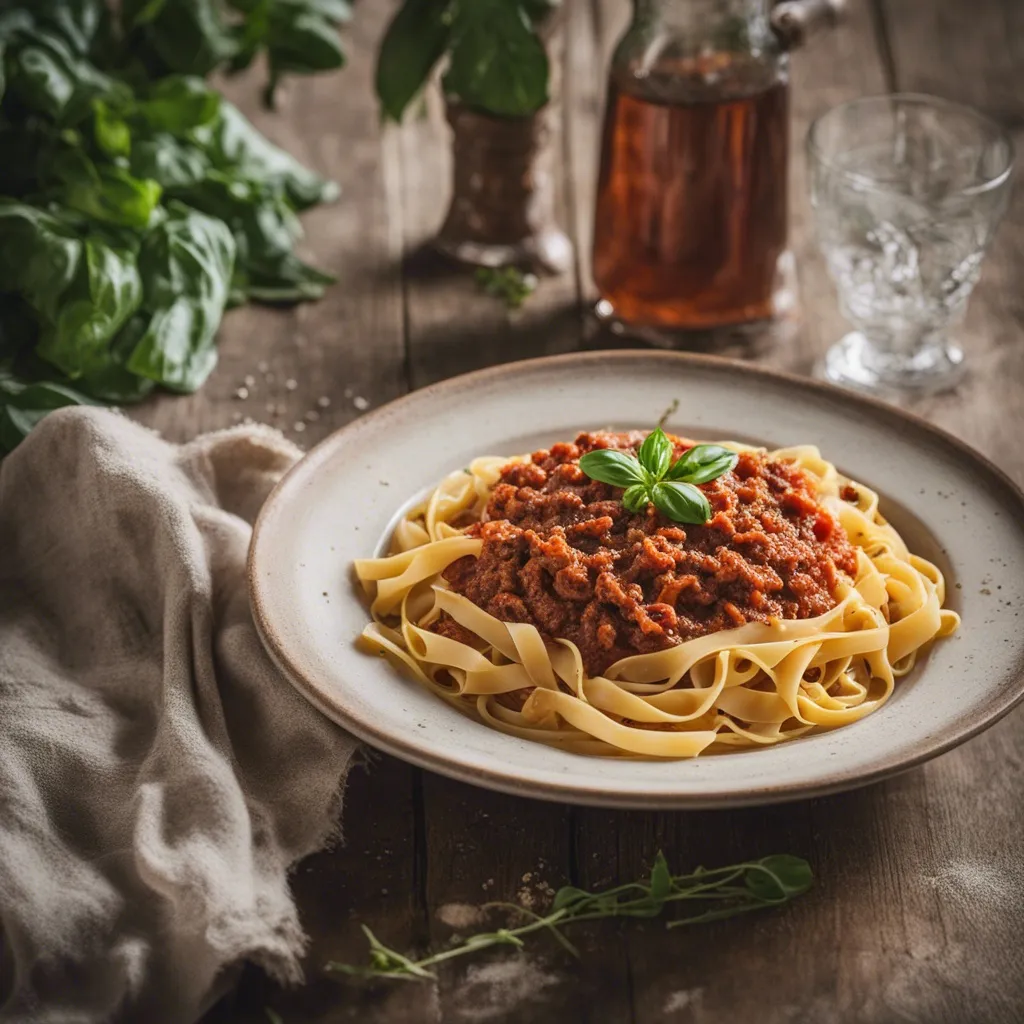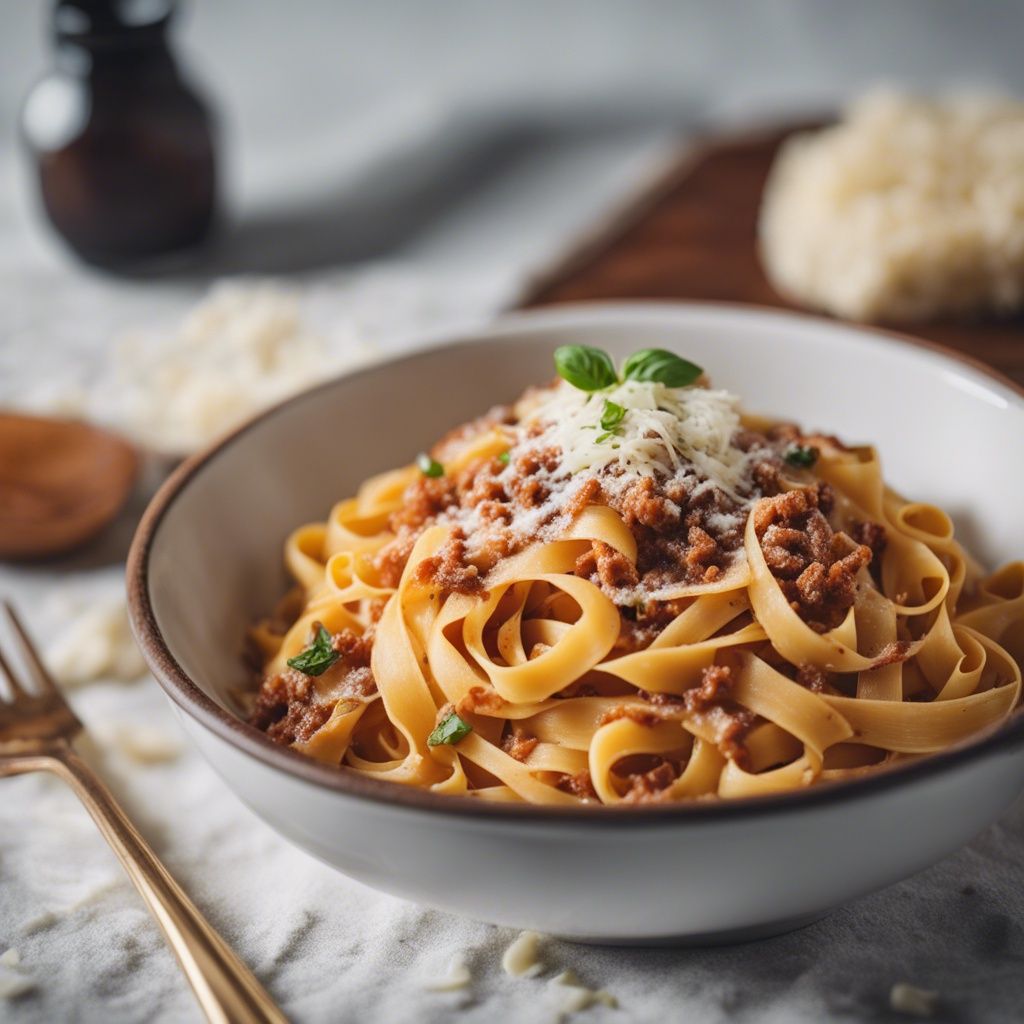Tagliatelle Bolognese
Tagliatelle Bolognese, a staple of Italian cuisine, has its roots deeply entrenched in Italy’s rich culinary history; this dish’s origins are often associated with the city of Bologna, renowned for its hearty cooking. Tagliatelle, the pasta used in this dish, is a traditional type of egg pasta known for its long, flat ribbons, ideally suited to hold onto the rich and meaty Bolognese sauce.

Why Tagliatelle?
With its long, flat ribbons, tagliatelle is wider than spaghetti and has more surface area, allowing this beautiful pasta to hold and absorb hearty, thicker sauces more effectively. The texture and thickness of tagliatelle provide a better balance with the rich and meaty Bolognese sauce - the pasta is a vehicle for the sauce, and tagliatelle ensures an even coating of BBolognese with every bite.
Even though there are many adaptations of spaghetti bolognese, spaghetti, with its thinner and round shape, is better suited for lighter, oil- or tomato-based sauces because its shape allows it to intertwine with these more fluid sauces, ensuring a good distribution of flavor. The choice of pasta can impact the overall experience of a dish; in fact, in Italian cuisine, pairing pasta shapes with specific sauces is an art form, reflecting a deep understanding of texture and flavor interactions.
The Base of Bolognese: Tomatoes
For preparing Tagliatelle Bolognese, the choice of tomatoes can significantly influence the flavor and quality of the sauce. Ideally, you want to use high-quality, flavorful tomatoes since they form the base of the Bolognese sauce. In this recipe, we opt for high-quality canned crushed tomatoes, which have a natural sweetness that enhances the dish’s flavor without adding extra sugar. However, if you’re looking for an alternative to canned crushed tomatoes, here are some options:
- San Marzano tomatoes: These are a variety of plum tomatoes known for their sweet flavor, firm pulp, low seed count, and low acidity, and many chefs consider them the best tomatoes for making sauces.
- Roma or plum tomatoes: If you’re opting for fresh tomatoes, they are a good choice as they have a meaty texture with fewer seeds and are less watery, making them ideal for a thicker sauce.
- Cherry tomatoes: While not traditional, cherry tomatoes can also be used for a sweeter and slightly tangy sauce, adding a different flavor profile to your Bolognese.
Regardless of the type of tomatoes used, it’s essential to cook them down properly to develop a rich, deep flavor that characterizes a classic Bolognese sauce - the slow cooking process allows the tomatoes to break down and meld their flavors with the other ingredients.

Beef: The Heart of the Dish
The meat used in the traditional Bolognese sauce, and what we opt for in this recipe, is ground beef, preferably with a fat content of around 20%, which might sound high, but remember – fat equals flavor! If you’re looking to use some other kind of meat, here are some possible options:
- Beef chuck: You can use beef chuck for a more textured and flavorful sauce. However, it needs to be ground or finely chopped.
- Mix of meats: Sometimes, a blend of ground beef, pork, and veal is used for added depth of flavor.
Cooking Bolognese
Cooking Bolognese in a Dutch oven? We’ve found it’s a game-changer for this classic Italian dish. Let’s tell you why we love this method! Firstly, with its thick walls and heavy base, the Dutch oven ensures even heat; this means no part of your sauce gets more heat than another - avoiding any burnt surprises. We love how this cookware locks in flavors, slowly melding the herbs, meat, and tomatoes into something truly special.

Here’s a tip we’ve picked up: while your sauce simmers, don’t forget to give it a gentle stir now and then. This simple step ensures everything cooks uniformly. And, if you’re like us, making a big batch of sauce for future meals, the Dutch oven’s size is super handy. Plus, the consistent heat helps thicken the sauce just right - not too watery or thick.
Are you serving sides?
We have some delicious sides that pair nicely with Tagliatelle Bolognese; here are our suggestions;
- Garlic bread: A classic choice; crispy on the outside, soft and garlicky inside, perfect for mopping up that delicious sauce.
- Green salad: A simple salad with a light vinaigrette balances the richness of the Bolognese.
- Roasted vegetables: Think bell peppers, zucchini, and eggplant, roasted to perfection.
- Caprese salad: Fresh tomatoes, mozzarella, basil, and a drizzle of balsamic glaze for a refreshing side.
- Sauteed spinach: Lightly seasoned with garlic and olive oil, it’s a healthy and flavorful addition.
- Grilled asparagus: A smoky, tender side that adds a nice contrast in texture.
- Steamed broccoli or green beans: Simple, healthy, and a great way to add greens.
- Bruschetta: Toasted bread topped with a mix of diced tomatoes, garlic, and basil for a light and tasty starter.
- Antipasto plate: Selection of cured meats, cheeses, and olives for an Italian touch.

Can I store Tagliatelle Bolognese in the fridge?
Freshness is paramount in Italian cuisine, and while Bolognese sauce can be stored in the refrigerator for up to 5 days in an airtight container, always pair it with freshly cooked tagliatelle.
Can I use a meat substitute in Bolognese for a vegetarian version?
Absolutely! Lentils, a textured vegetable protein, or finely chopped mushrooms are great meat substitutes that still give the sauce a rich, hearty texture and flavor.
How long should I simmer the Bolognese sauce?
For the best flavor, simmer the sauce for at least 30 minutes. However, if you have time, letting it simmer for 1-2 hours will deepen the flavors even more.
What are the best wines to pair with Tagliatelle Bolognese?
A medium-bodied red wine like Chianti, Merlot, or a Sangiovese pairs beautifully with the rich flavors of Bolognese - these wines complement the meaty sauce without overpowering it.
Can Tagliatelle Bolognese be frozen for later use?
Yes, you can freeze the Bolognese sauce for up to 3 months. It's best to freeze the sauce separately from the pasta. Thaw in the refrigerator overnight before reheating and serving with freshly cooked pasta.
Tagliatelle Bolognese
Tagliatelle bolognese is probably the perfect comfort food - the thick sauce is packed with deep and rich flavor, and coats the tagliatelle beautifully. It’s a great mid-week recipe since it’s so quick to make, but it’s also great for a weekend indulgence!
Cuisine
Italian
Serves
4
Prep
15 mins
Cook
30 mins
Total
45 mins
Calories
740 kcal

Ingredients
1.5 tablespoon olive oil
2 cloves garlic
1 finely chopped white onion
1 lb beef mince (ground beef)
½ cup red wine
2 beef bouillon cubes
28 oz can crushed tomato
2 tablespoons tomato paste
2 tablespoons worcestershire sauce
2 dried bay leaves
2 sprigs of fresh thyme
1 teaspoon salt (adjust to taste)
1 teaspoon pepper (adjust to taste)
Instructions
Heat 1 & ½ tablespoons oil in a pot or a Dutch oven on medium-high heat. Once the pot has heated up, add the chopped onion and minced garlic for roughly 3 minutes until the garlic is a light golden brown and the onion has softened.
Turn up the heat to a high temperature and add the 1lb of beef. Cook the beef until browned.
Once the beef is browned, add ½ cup of red wine. Bring the pot to simmer and cook the mixture for 1 minute while mixing continuously. Make sure to scrape the bottom of the pot while mixing and do so until the alcohol smell is gone.
Add all the remaining ingredients except the salt and pepper (we will add this at the end). Stir everything until the mixture is combined and bring the pot to a simmer. Turn down the pot to medium heat so that the mixture will bubble gently. Simmer for at least 20-30 minutes with the lid off, and add water if the water gets too thick for your liking.
Add the salt and pepper once the bolognese is cooked and thickened to your liking.
Notes
Slow cooking: You can leave the bolognese to cook on a slow simmer. To do this, add ¾ cup of water and cover the pot with a lid. Simmer the sauce on very low heat for 2 - 2 & ½ hours. Make sure to stir the sauce every 20 - 30 minutes. Once the sauce has cooked for roughly 2 hours, uncover the pot and simmer for 20 minutes. This will thicken the sauce.
Tossing tagliatelle: When adding the sauce to the cooked tagliatelle, leave some pasta water aside (~¼ / ½ cup of pasta water). When mixing the bolognese with the tagliatelle, do so in a pot over medium heat and then add the pasta water to your tagliatelle bolognese. Mix for roughly 1 minute until everything is combined and the tagliatelle is completely covered in sauce. When serving, sprinkle parmesan and chopped parsley over the tagliatelle bolognese if desired.
Nutrition
- Calories 740 kcal |
- Carbohydrate Content 86 g |
- Cholesterol Content 68 mg |
- Fat Content 26 g |
- Fiber Content 6.5 g |
- Protein Content 39 g |
- Serving Size 1 portion |
- Sodium Content 2.4 g |
- Sugar Content 9 g |
About the author
Emma Donin is the culinary maestro behind this blog that serves as a melting pot of global cuisines and gastronomic adventures. Her culinary journey began in her grandmother's kitchen, where she learned the fundamentals of cooking and the importance of using fresh, quality ingredients.
